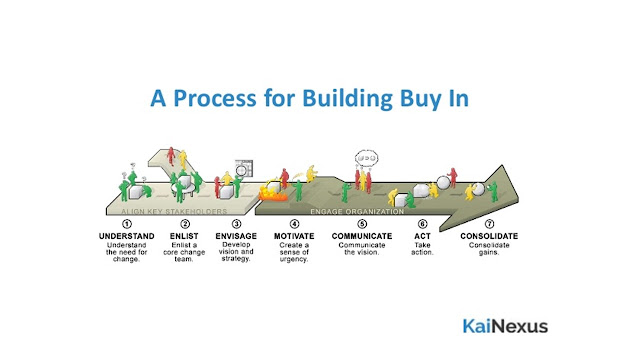What is buy-in?
Before we go any further, let’s
define buy-in. I define it as the willingness to support an action or decision.
And I’m a huge fan of the process to achieve buy-in. As a general rule, I think
most people are.
What keeps us from getting buy-in?
That being said, there are a couple
of things about getting organizational buy-in that keep us from actually doing
it:
1.It
takes time. In some cases, a lot of time. So we have to be patient when
creating buy-in.
2.Buy-in
requires us to know our audience incredibly well. We have to communicate the
message the way the audience wants to receive it.
These are the concerns top managers
(and everyone else) have with buy-in.
People will ask, “Has everyone
bought in?” without giving the process enough time. Or they say, “We need to
get buy-in.” without thinking about how the message is being delivered.
Individuals want buy-in but they
don’t always want or have the means to make buy-in happen.
And in fairness, it’s not always the manager’s fault. Companies might decide to implement a new policy or procedure and look for management to get buy-in for the change. But they often don't provide the time or the resources to create buy-in.
8 steps to success in getting
organizational buy-in
Remember the goal: to get support
for an action or decision.
1. Understand the other person’s
communication style.
When you're trying to create buy-in, it’s about them (i.e. your
audience).
If you want their support, then you must deliver the message their way. At a
time that works for them. In the environment that also works for them.
2. Create a conversation based on
trust and respect.
Is the thing you’re trying to get buy-in for confidential or sensitive? It
wouldn't be unusual to be soliciting support for something that needs to remain
a secret — at least for the time being. If so, you’ll want to initiate the
conversation so that the other person knows and respects that confidence.
3. Clearly understand the change. If
you’re going to ask for someone’s support, you need to know what you’re talking
about. Often conversations about buy-in start with a discussion of the past — a
problem or challenge that’s prompting a change. It's critical to have the facts
straight.
4. Prepare for questions.
Once the conversation starts, questions are sure to arise, such as “When is
this going to happen?” As the person initiating the discussion, you want to be
honest and knowledgeable.
5. Know if the change is
negotiable. This
is tough. Buy-in conversations can generate good ideas. Can those good ideas be
considered? Or has a final decision been made? Be prepared to address this both
during the meeting with the person you're asking for support and after the
meeting with senior management.
6. Ask the question.
You’re at the point where you need to ask for the person’s support. You’ve
talked about the change, you’ve answered questions and listened to suggestions.
Be clear about what you’re asking for. “Can I count on your support for
________?”
7. Determine how to handle feedback.
This ties into #6. Make sure you have a clear yes or no response. It might be
“Yes, but only if you do this…” Or “No, unless you do that…” But creating
buy-in is never about vague responses.
8. Follow-up appropriately.
Regardless of the person’s reply, thank them for considering the request. You
might not agree with their decision, but it’s
important to keep the working relationship on a positive tone.
Also, let them know what you'll do with any comments that they’ve made.
Could the process below lead to more effective buy-in when launching an initiative?


Comments
Post a Comment